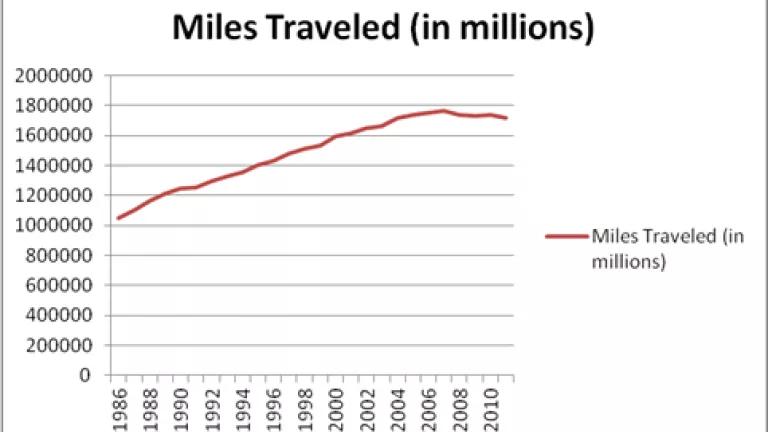
While prospects for legislation to curb energy use and reduce greenhouse gases look bleak, there is heartening news that citizens are taking steps to do both on their own: The most recent numbers from the U.S. Department of Transportation indicate that a six-year old trend of declining car usage is continuing.
In the first eight months of this year, car usage — the number of miles traveled or vehicle miles traveled (VMT) — declined 1.3 percent in the United States, to the lowest level since 2003. This is a continuation of a trend that began in 2004, when usage began to plateau. In 2007, the number of miles traveled began to decline (see graph below, which I created using Data from the FHWA's HPMS).
And there is evidence that the emerging trend isn't confined to the United States. Driving has been declining in cities worldwide, from London to Sydney.
If this trend continues, it will significantly contribute to a decline in the use of fossil fuels and in greenhouse gas emissions since vehicle usage, along with efficiency and energy source, are the three critical variables determining emissions and fuel consumption levels. The trend is also likely to add impetus to the development of alternative forms of transportation and of urban design less dependent on cars, and thus to a self-perpetuating, virtuous cycle.
Most heartening of all about the trend is that it is not simply a result of high gas prices or the recession. The plateauing of passenger car and truck usage beginning in 2004 came well before the recession, which began in 2008. And, throughout the period, gas prices have been highly volatile while the downward trend in driving has been steady. It is possible that the very volatility in gas prices has caused people to decrease their dependence on cars. And, certainly the recession, highly unwelcome despite any positive impact it may have on the environment, has been a factor in discouraging car use, but neither of these factors entirely account for the trend.
Several other explanations have been suggested.
One is that two major population cohorts — aging baby boomers and Generation Y — are, for different reasons, driving less. Baby boomers are likely to be contributing to the trend, and to do so increasingly, because people generally drive less as they age; once people stop working full time, they tend to drive half as much as they did when they worked. As I believe I've written about before, my parents -- who live across the Potomac in the suburb of Reston, Virginia -- are a great example. After all three of us kids left the nest, they moved from a detached house with a two car garage complete with two autos to an attached townhouse and one seldom-used Toyota Prius.
“Cars are so 20th Century”
A large segment of Generation Y, meanwhile, is opting to live in urban areas, both responding and contributing to the widespread redevelopment and revitalization of these areas. For them, the combination of cultural, social and lifestyle attractions that cities hold and perhaps an awareness of the unsustainability of a car culture, have led them to flock to cities. As evidence of the phenomena, the rate of license acquisition among Generation Y is significantly lower than that of earlier generations.
The so-called Marchetti constant offers a third explanation. The constant, based on observations going back to the ancient cities of Greece and Italy, holds that people everywhere and throughout history have sought to limit their travel time to and from work to one hour. Evidence for the theory can be seen in the size of ancient Greek cities, Rome, Persepolis and Venice even today; their diameters were limited to the distance a person can travel on foot in one hour – about 5 kilometers. As modes of transportation have become faster, cities have expanded, but largely according to the dictates of the constant. But, with ubiquitous congestion, people have found that in cities built to a size that assumes they can travel in cars at 50 mph, they have to far exceed their one-hour allotment for commuting time. So, they are abandoning their cars and turning to alternative forms of transportation, according to this explanation.
Further research must be done to determine which and to what degree these factors are propelling the declining use of cars. Depending on what we learn, we will have more or less cause for optimism that forces outside of government will continue to lead us in a promising direction.
